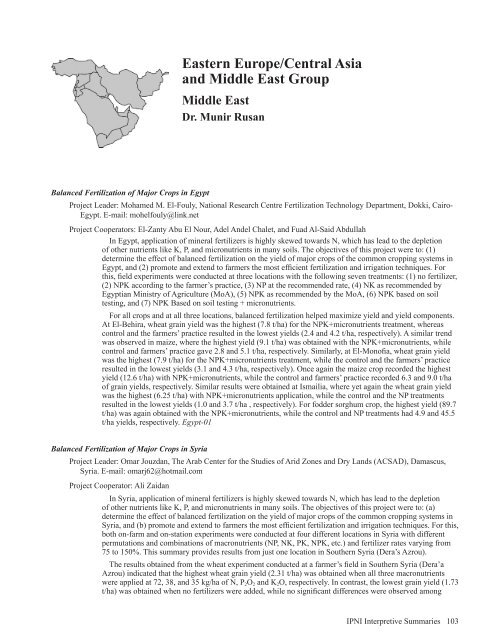Americas and Oceania Group - International Plant Nutrition Institute
Americas and Oceania Group - International Plant Nutrition Institute
Americas and Oceania Group - International Plant Nutrition Institute
You also want an ePaper? Increase the reach of your titles
YUMPU automatically turns print PDFs into web optimized ePapers that Google loves.
Eastern Europe/Central Asia<br />
<strong>and</strong> Middle East <strong>Group</strong><br />
Middle East<br />
Dr. Munir Rusan<br />
Balanced Fertilization of Major Crops in Egypt<br />
Project Leader: Mohamed M. El-Fouly, National Research Centre Fertilization Technology Department, Dokki, Cairo-<br />
Egypt. E-mail: mohelfouly@link.net<br />
Project Cooperators: El-Zanty Abu El Nour, Adel Andel Chalet, <strong>and</strong> Fuad Al-Said Abdullah<br />
In Egypt, application of mineral fertilizers is highly skewed towards N, which has lead to the depletion<br />
of other nutrients like K, P, <strong>and</strong> micronutrients in many soils. The objectives of this project were to: (1)<br />
determine the effect of balanced fertilization on the yield of major crops of the common cropping systems in<br />
Egypt, <strong>and</strong> (2) promote <strong>and</strong> extend to farmers the most efficient fertilization <strong>and</strong> irrigation techniques. For<br />
this, field experiments were conducted at three locations with the following seven treatments: (1) no fertilizer,<br />
(2) NPK according to the farmer’s practice, (3) NP at the recommended rate, (4) NK as recommended by<br />
Egyptian Ministry of Agriculture (MoA), (5) NPK as recommended by the MoA, (6) NPK based on soil<br />
testing, <strong>and</strong> (7) NPK Based on soil testing + micronutrients.<br />
For all crops <strong>and</strong> at all three locations, balanced fertilization helped maximize yield <strong>and</strong> yield components.<br />
At El-Behira, wheat grain yield was the highest (7.8 t/ha) for the NPK+micronutrients treatment, whereas<br />
control <strong>and</strong> the farmers’ practice resulted in the lowest yields (2.4 <strong>and</strong> 4.2 t/ha, respectively). A similar trend<br />
was observed in maize, where the highest yield (9.1 t/ha) was obtained with the NPK+micronutrients, while<br />
control <strong>and</strong> farmers’ practice gave 2.8 <strong>and</strong> 5.1 t/ha, respectively. Similarly, at El-Monofia, wheat grain yield<br />
was the highest (7.9 t/ha) for the NPK+micronutrients treatment, while the control <strong>and</strong> the farmers’ practice<br />
resulted in the lowest yields (3.1 <strong>and</strong> 4.3 t/ha, respectively). Once again the maize crop recorded the highest<br />
yield (12.6 t/ha) with NPK+micronutrients, while the control <strong>and</strong> farmers’ practice recorded 6.3 <strong>and</strong> 9.0 t/ha<br />
of grain yields, respectively. Similar results were obtained at Ismailia, where yet again the wheat grain yield<br />
was the highest (6.25 t/ha) with NPK+micronutrients application, while the control <strong>and</strong> the NP treatments<br />
resulted in the lowest yields (1.0 <strong>and</strong> 3.7 t/ha , respectively). For fodder sorghum crop, the highest yield (89.7<br />
t/ha) was again obtained with the NPK+micronutrients, while the control <strong>and</strong> NP treatments had 4.9 <strong>and</strong> 45.5<br />
t/ha yields, respectively. Egypt-01<br />
Balanced Fertilization of Major Crops in Syria<br />
Project Leader: Omar Jouzdan, The Arab Center for the Studies of Arid Zones <strong>and</strong> Dry L<strong>and</strong>s (ACSAD), Damascus,<br />
Syria. E-mail: omarj62@hotmail.com<br />
Project Cooperator: Ali Zaidan<br />
In Syria, application of mineral fertilizers is highly skewed towards N, which has lead to the depletion<br />
of other nutrients like K, P, <strong>and</strong> micronutrients in many soils. The objectives of this project were to: (a)<br />
determine the effect of balanced fertilization on the yield of major crops of the common cropping systems in<br />
Syria, <strong>and</strong> (b) promote <strong>and</strong> extend to farmers the most efficient fertilization <strong>and</strong> irrigation techniques. For this,<br />
both on-farm <strong>and</strong> on-station experiments were conducted at four different locations in Syria with different<br />
permutations <strong>and</strong> combinations of macronutrients (NP, NK, PK, NPK, etc.) <strong>and</strong> fertilizer rates varying from<br />
75 to 150%. This summary provides results from just one location in Southern Syria (Dera’s Azrou).<br />
The results obtained from the wheat experiment conducted at a farmer’s field in Southern Syria (Dera’a<br />
Azrou) indicated that the highest wheat grain yield (2.31 t/ha) was obtained when all three macronutrients<br />
were applied at 72, 38, <strong>and</strong> 35 kg/ha of N, P 2 O 2 <strong>and</strong> K 2 O, respectively. In contrast, the lowest grain yield (1.73<br />
t/ha) was obtained when no fertilizers were added, while no significant differences were observed among<br />
IPNI Interpretive Summaries 103

















